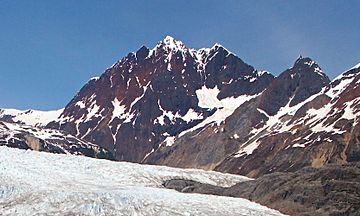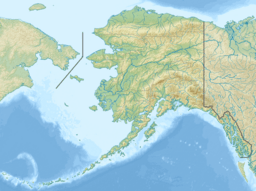Black Mountain (Alaska) facts for kids
Quick facts for kids Black Mountain |
|
|---|---|

Black Mountain, southwest aspect
|
|
| Highest point | |
| Elevation | 5,891 ft (1,796 m) |
| Prominence | 1,548 ft (472 m) |
| Isolation | 4.2 mi (6.8 km) |
| Geography | |
| Location | Glacier Bay National Park Hoonah-Angoon Alaska, United States |
| Parent range | Alsek Ranges Saint Elias Mountains |
| Topo map | USGS Skagway A-3 |
| Climbing | |
| Easiest route | North slope |
Black Mountain is a tall mountain in southeast Alaska. It stands 5,891 feet (1,796 meters) high. This mountain is part of the Alsek Ranges within the larger Saint Elias Mountains.
You can find Black Mountain inside Glacier Bay National Park and Preserve. It is about 75 miles (121 km) northwest of Juneau, Alaska's capital city. The mountain sits between two large ice rivers called the Riggs and McBride glaciers.
The best time to visit or climb Black Mountain is from May through June. The weather is usually good then. If the weather is clear, you can see Black Mountain from Muir Inlet. This area of Glacier Bay is a popular spot for cruise ships.
Mountain Weather and Climate
Black Mountain has a subarctic climate. This means it has very cold, snowy winters. The summers are cool, but not warm.
Weather systems often come from the Gulf of Alaska. When they reach the Saint Elias Mountains, the air is forced to rise. This process is called orographic lift. As the air rises, it cools down. This causes a lot of rain and snow to fall on the mountains.
Winter temperatures can drop very low, sometimes below −20 °C. With the wind, it can feel even colder, below −30 °C. This cold climate helps keep the glaciers around Black Mountain. The Riggs Glacier is on the west side, and the McBride Glacier is on the east.


